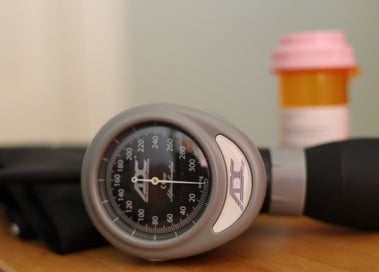
In another article, Ive explained the key reasons that I recommend older adults and their caregivers have a blood pressure (BP) monitor at home. To very briefly recap: Many of the problems of older adults (including falls) can be related to blood pressure. Home blood pressure measurements can help: evaluate for drops in blood pressure with standing (a common cause of dizziness in elders) check for serious illness, since these often (but not always) cause the blood pressure and pulse to be very different from usual follow-up on blood pressure after a change in medication, which can help doctors and families figure out the best medication dosing for an older person much faster.This is safer for seniors. In this post, Ill share some tips on choosing and using a home BP monitor. And dont worry: I wont tell you that you have to plan on checking every day for the rest of your lives.Although there are times when its great to check daily like the week after a change in medication the most important thing is to have a good BP monitor at home and know how to use it at least occasionally. I also share some more guidance and advice in my Youtube video on high blood pressure here: Tips for choosing a home blood pressure monitor Here are the most important criteria to consider when choosing a BP monitor: Is it easy to get accurate readings? Accurate and reliable readings are key.
To find an accurate BP meter for home: Get an automatic digital monitor.Although manual cuffs are available, these require more training to use properly. A good quality digital monitor will usually be more accurate and easier to work with over time. Choose a monitor with a cuff that measures at the upper arm. Wrist and finger cuffs tend to give inaccurate readings if the body position isnt just-so. Pick a BP monitor that has good reviews from Consumer Reports, the Wirecutter, or another reputable review organization. Customer ratings at Amazon and other big online stores can also be helpful. Plan to bring the BP monitor to the doctors office, so that staff can compare the monitors reading to their own clinic monitor.This is a good way to check the cuffs accuracy. Is the arm cuff properly-sized?Its absolutely essential to have a cuff that is the right size for the persons arm.
Cuffs are usually available in sizes small, standard, and large. A cuff that is too small will give readings that are falsely high, while a cuff that is too big will give readings that are falsely low. According to the Mayo Clinic: The inflatable part of the blood pressure cuff should cover about 80% of the circumference of your upper arm.The cuff should cover two-thirds of the distance from your elbow to your shoulder. To purchase a cuff, start by measuring the older persons arm around the bicep area, using a cloth measuring tape. 7-9 inches > small cuff 9-13 inches > standard cuff 13-17 inches > large cuff more than 17 inches > ask the doctor for help finding an extra-large cuff, or even a thigh cuff Note: Some BP monitors come with a preformed cuff whereas others come with a D-ring cuff.A preformed cuff is often easier to put on, but may not cinch down easily to its smallest dimension.
If you have a smaller or larger arm, a BP monitor with a preformed cuff may not work well for you.
Is it easy to log the readings and share with the doctor?Remember, youll get a lot more help from a home BP monitor if its easy to log the readings and share the information with doctors or nurses when necessary.
Most digital BP monitors will store a certain number of readings in the monitor; some can even store readings for two different people.
But readings stored within the monitor can be hard to share with the doctor, so families often still log the blood pressure readings by hand.
Some BP monitors can connect to your home computer, so that the readings can be downloaded.
Check user reviews to make sure that most people have found this feature easy to use.
Many BP monitors can connect via Bluetooth to a smartphone, which is very convenient when it works well.
You can Google bluetooth blood pressure monitor and pick a one that has good user reviews.
Can the older persons doctor recommend a home BP monitor?Although many doctors arent prepared to recommend a specific kind of home BP monitor, some primary care clinics are starting to regularly recommend home BP monitoring.See if your healthcare team can suggest a specific home device that they are used to working with.
If your doctor cant recommend a home BP monitor, I suggest considering a home BP monitor from Omron, such as one of these:
Omron Silver BP Monitor *
Features Bluetooth and a preformed cuff.
Omron Gold BP Monitor *
Features Bluetooth, a D-ring cuff (usually better for smaller arms), and can save readings for two users (which is great for couples).
Omron is a well-established brand that also makes professional-grade monitors for healthcare use, and consumer reviews are pretty positive.
(*Note: These are Amazon affiliate links.Purchasing through these links helps support Better Health While Aging.)
Tips for using a home blood pressure monitor
In general, when I advise families on using a home BP monitor, we cover three key topics: proper technique, when in the day to check, and how often every week to check.
Proper technique:The most important things to keep in mind are the position of the arm, and relaxing.
The upper arm with the BP cuff should be positioned at about the level of the heart (upper chest).
A good way to do this is to have the older person sit in a chair, and rest the arm on a table nearby. Dont have the person hold their arm up and out.The arm with the cuff should be fairly relaxed.This sometimes means another person has to hold the arm up at the level of the upper chest. Check the blood pressure when the person is quiet and relaxed.
Talking, exercising, or getting revved up can increase the blood pressure. When in the day to check: The conventional wisdom often suggests checking in the morning, before taking medication.However, because overtreatmentof high blood pressure is such a common problem in the elderly, I often suggest that people check BP about an hour after taking any blood pressure medication. If the older person is taking blood pressure medication, consider checking BP about an hour after the medication is taken, especially if there has been any concern about falls, dizziness, or poor balance. Also consider checking the blood pressure sitting and standing if there has been any concern for falls.(See this post for more details on the common problem of blood pressure dropping with standing.) Be sure to record what time of day the BP is checked.
If you are monitoring BP regularly for a few days or weeks or even indefinitely, try to check at the same time(s) every day. How often to check: You could certainly check every day, or even several times every day.But I find that caregivers and older adults often find checking BP tiresomethey usually have lots of other things to do! So how often to check depends on a) whats going on with the persons health, and b) whats feasible for the elder and caregiver. If the health issues seem stable and there have been no recent medication changes, consider checking BP once a week.This will provide some baseline information, so that when a health issue crops up, the doctors will be able to tell if a change in blood pressure seems related to the new or worsened symptoms. If a blood pressure medication has been changed, or if you are worried about an older persons health, try checking at least once a day for 7 days. What to discuss with the doctor Just how should you use a home BP monitor to improve an older persons health without too much hassle? The best approach is to ask the doctor for some advice, because in the end, it really depends on the particular health circumstances of every patient. The goal, after all, of collecting BP data at home, is to gather information that can help the doctors help you.
(And to help the doctors spot problems like postural changes in blood pressure that they might not otherwise notice in a busy clinic visit.) Here are some questions you can ask the doctor: We have a home blood pressure monitor.How often would you recommend we check my mothers blood pressure? What time of day do you think it would be most useful for us to check her blood pressure? Do you think its likely to help if we check her home BP every day indefinitely? Or would it be ok if we just check once per week? Were a little concerned because she occasionally falls or feels unsteady.Do you think its possible that she might be on a little higher dose of blood pressure medication than she needs? Would it be helpful if we checked her BP sitting and standing for a few days? For more on what doctors should check, see this article:8 Things to Have the Doctor Check After an Aging Person Falls. Weve been checking her BP sitting and standing over the past few days, and we noticed that the standing BP is often quite a bit lower.
Couldnt this lead to falls? Would it be possible for us to try lowering her BP medication a bit? Were having trouble checking the BP every daywere just a bit overwhelmed by things.How much should we prioritize checking BP every day? Could we perhaps check less often? Key take-home points A home BP monitor is a very useful tool for older adults, and I always recommend families get one and learn to use it. When choosing a home BP monitor, look for a well-reviewed digital BP machine that measures BP in the upper arm.Be sure to get a properly sized arm cuff, and have the accuracy of the machine checked at the doctors office. Do think about how you will log the BP readings and share with the doctor.
Consider a BP monitor that can send the readings to your smartphone or computer.At the very least, you may need to write down the BP numbers on a paper log (easier for you to do) or in a spreadsheet (easier for the doctors to assess). In this post, I offer some suggestions on what time of day to check, and how often.But the best is to talk to the older persons doctor, to set up a plan that is a good fit for the older persons medical situation (and still manageable for you!). For more on better blood pressure management in older adults, see my post What the Blood Pressure Guidelines & Research Mean for Older Adults. This article was last updated by Dr.
K in July 2025.
Disclaimer: This story is auto-aggregated by a computer program and has not been created or edited by Senior Savings Deals.
Publisher: Better Health ( Read More )
Publisher: Better Health ( Read More )

